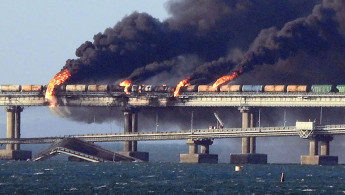Why is the bridge linking Russia to the Crimean peninsula so critical?
The road-and-rail bridge linking Russia and the Crimean peninsula was damaged in a powerful blast on Saturday, hitting a crucial supply route for Russian forces in Ukraine.
The following are key facts about the bridge.
Crimea and Russia link
The 19-km (12-mile) Crimea Bridge over the Kerch Strait is the only direct link between the transport network of Russia and the Crimean peninsula, which Moscow annexed from Ukraine in 2014.
The bridge was a flagship project for Russian President Vladimir Putin, who opened it himself for road traffic with great fanfare by driving a truck across in 2018.
⚡️Eyewitnesses post photos, video of the fiercely burning Kerch bridge.
— The Kyiv Independent (@KyivIndependent) October 8, 2022
The Kerch bridge from Russia to Crimea has been hit by a massive explosion on the span that carries railway traffic early on Oct. 8. pic.twitter.com/5wvIjBZmZZ
It consists of a separate roadway and railway, both supported by concrete stilts, which give way to a wider span held by steel arches at the point where ships pass between the Black Sea and the smaller Azov Sea.
The structure was built, at a reported cost of $3.6 billion, by a firm belonging to Arkady Rotenberg, a close ally and former judo partner of Putin.
Why it matters
The bridge is crucial for the supply of fuel, food and other products to Crimea, where the port of Sevastopol is the historic home base of Russia's Black Sea Fleet.
It also became a major supply route for Russian forces after Moscow invaded Ukraine on Feb. 24, sending forces from Crimea to seize most of southern Ukraine's Kherson region and some of the adjoining Zaporizhzhia province.
Russia's Defence Ministry said on Saturday that those troops could be fully supplied by existing land and sea routes.
What has been destroyed
The blast on Saturday brought down sections of the road taking traffic in one direction.
Traffic was initially suspended after the incident but by Saturday evening cars and buses were allowed to start crossing the bridge in alternating directions on the remaining intact lanes, while heavy goods vehicles waited to cross by ferry.
The span through which ships pass the strait was reportedly not damaged.
(Reuters)





 Follow the Middle East's top stories in English at The New Arab on Google News
Follow the Middle East's top stories in English at The New Arab on Google News


